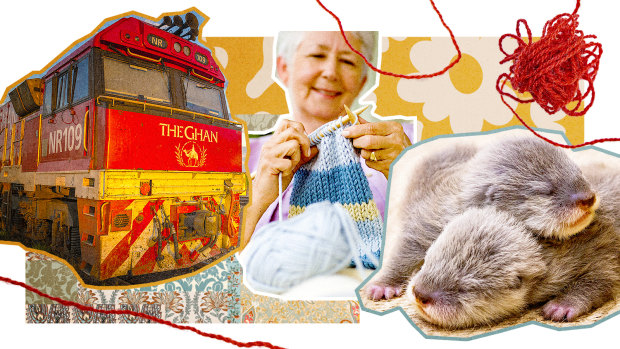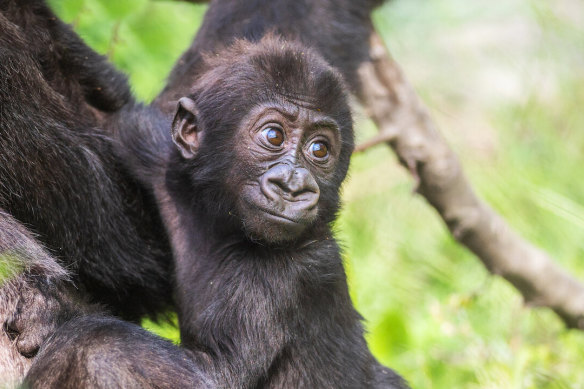
Save articles for later
Add articles to your saved list and come back to them any time.
Last week, Netflix released Baby Animal Cam – livestreamed footage of animals in Cleveland Metroparks Zoo. Unlike the story-driven television we’re used to watching, this program has no narration and minimal editing. It broadcasts two uninterrupted hours of baby gorillas, rhinos, orangutans and otters merely… existing.
It might sound dull, but nature can be innately captivating; imagine getting lost in the sound of a babbling brook or mesmerised by a chimpanzee eating a particularly stubborn bamboo shoot. These types of broadcasts, sometimes marathon in length, have become popular enough to inspire a distinct genre: Slow TV. In a fast and confronting world, could this be the answer to slowing our minds down?
Slow TV may seem boring at first, but it could be the meditative entertainment we need to calm us down.Credit: Compiled by Aresna Villaneuva
What is Slow TV?
Slow TV programs generally consist of hours-long coverage of ordinary events in their complete length.
Spencer Stoner – a producer at Greenstone TV, which released New Zealand Slow TV programs Go South and Go Further South – says it originated in Norway in 2009. The first was a seven-hour train journey from Bergen to Oslo called Minutt for Minutt. Since then, other locations and storylines have been produced, including a 134-hour ferry ride from Bergen to Kirkenes, a 14-hour birdwatching broadcast and 18 hours of live salmon fishing.
Australian Slow TV began in 2018 with Mint Pictures’ series for SBS, which included The Ghan, The Indian Pacific – Australia’s Longest Train Journey and The Kimberley Cruise (2019).
Livestreams of baby animals have proven so popular that Netflix created a follow-up series to Baby Gorilla Cam.Credit: Netflix
The broadcasts have developed a kind of cult following, says Dan Goldberg, creative director of Mint Pictures, whose 17-hour program of the Ghan train became SBS Vice’s highest-rating show.
The same goes for broadcasts involving animals. Netflix has created two baby animal livestream series – Baby Animal Cam and Baby Gorilla Cam. Similarly, Melburnians became transfixed by a 24/7 livestream of peregrine falcons laying their eggs on top of a CBD building during the COVID-19 lockdowns, attracting nearly 40,000 people. Live footage of penguins returning to their burrows on Phillip Island each night was also a hit.
The art of Slow TV
Unlike traditional narrative television, Goldberg says Slow TV contains no drama, no narration, no dialogue, no fast cuts nor major edits. However, it still has a story to tell.
“The end-game, so to speak, is that the train reaches its destination, or the chocolate eggs reach the shelves in time for Easter,” Goldberg says. “Along the way we do tell stories, via graphics, that offer viewers interesting, eclectic and sometimes quirky history.”
It usually works best when delivering a beginning, middle and end. “Viewers need something to hang in for. When the 17-hour version of The Ghan aired on VICE in 2018, the audience climbed as the train was approaching Darwin. It seemed people were desperate to will it to its destination. In a sense, they want resolution or closure because they’ve invested so much of their time.“
Overall, Goldberg says each show must follow something worth sharing. For example, watching a train travel 4352 kilometres in The Indian Pacific may sound dull, but it captures some of the remotest parts of Australia, as well as important Indigenous landmarks. It’s not just watching paint dry, it’s an opportunity to connect with nature and history.
Monotonous or meditative?
President of the Australian Clinical Psychology Association, professor Caroline Hunt, says Slow TV can focus the mind and act as a form of meditation. “It may cause individuals to become more mindful, that is, focused on the moment and less likely to be caught up in the cycle of their daily worries,” Hunt says.
The content of the show doesn’t necessarily matter, she adds, as long as it’s neutral and pleasant to watch. Hence, why there are so many forms of Slow TV, from ferry rides to reindeer migration, the only prerequisite being that it requires minimal mental processing.
Social psychologist Brock Bastian says it elicits emotion the way other cinematic genres do. But while horror evokes fear, Slow TV evokes calmness and contemplation. He says much of this probably comes down to the green, natural spaces Slow TV captures, which can have a genuine psychological effect on viewers.
“It’s the biophilia hypothesis, which says humans have this innate motivation to connect with nature and natural things. You’re able to connect with these spaces in a calm and methodical way.”
Similarly, shows like Baby Animal Cam, which follows vulnerable infant animals, appeal to audiences’ nurturing side, potentially even releasing oxytocin (the “love” hormone), though Bastian notes it has not yet been proven whether watching television could properly elicit such biological reactions.
“People often have trouble switching off their minds or not thinking about the future or past. [Slow TV] slows us down by virtue of the speed of the imagery,” Bastian says. “It relaxes, calms and pleasantly distracts people in a very busy and hectic world.”
Not everyone has the time or patience to watch five hours of non-stop knitting, Bastian admits, but it could be something to play in the background as a reminder to regularly re-centre your thoughts.
A collective experience
Many Slow TV shows are livestreamed, thereby connecting viewers through the shared experience of witnessing nature at its purest. For example, the original broadcast of Minutt for Minutt was watched by over 1.2 million Norwegians. Other shows have done similarly well, such as the 8-hour broadcast of burning firewood which attracted nearly 20 per cent of the Norwegian population in 2013, and The Ghan’s journey between Adelaide and Darwin, which Goldberg says drew over 1 million cumulative viewers in 2018.
“It’s a really social form of TV,” Stoner says, noting the conversations on social media the genre inspires. “The pace of action opens up space for people to chat and reflect on what they’re seeing without having to worry about missing something.”
It’s also innately inclusive, Stoner says, providing content that can be enjoyed regardless of one’s circumstance.
“We’ve gotten letters from people who are neurodiverse saying it’s the only TV they’ve been able to watch, or those with disabilities thanking us because they felt they were able to travel in a way they couldn’t in real life.”
Hunt agrees, adding that watching Slow TV in the background could potentially distract people from feelings of loneliness. “There’s been some speculation that listening to podcasts or radio talk shows across the day could be helping people to feel less lonely, and it’s plausible that Slow TV could bring some of the same effect.”
Find out the next TV, streaming series and movies to add to your must-sees. Get The Watchlist delivered every Thursday.
Most Viewed in Culture
From our partners
Source: Read Full Article

